 On a smog-sighing spring afternoon in Los Angeles, I met my soul mate. Possibly two soul mates.
On a smog-sighing spring afternoon in Los Angeles, I met my soul mate. Possibly two soul mates.
Tuesday was a charmed day, my last full one before I hit the highway and headed back up the green spine of California. I ultimately failed in my scurrying attempt to cram in everything I hadn’t gotten to in the previous days—but I did encounter, sheerly by happenstance, two kindred spirits, cosmically bound in a coruscating tango set to the tune of my greatest loves: the unexpected beauty of travel, and sugar.
I got to Glaco’s Soda Pop Stop the round-about way. I learned about the Highland Park neighborhood (where Glaco’s has operated since 1897) through Trekking Los Angeles, a non-profit that aims to leverage cultural tourism to bring financial benefit to underserved communities. A pretty bad-ass ambition, and especially interesting given the recent spark in the ongoing debate about the cultural benefits/damages of tourism at World Hum and Matador. But how would it play out practically? I tried out one of their neighborhood guides.
The Highland Park guide focused mostly on art galleries and community spaces, which though interesting yielded a pretty incomplete neighborhood guide. I cruised past several of the galleries, finding only one open, and discovered the crowning Southwest Museum to be closed indefinitely due to earthquake damage.
 What I ended up finding coolest was just wandering the streets. Far from trendy and slick, Highland Park is a diverse, working class community (not too different from Oakland) filled with raspado carts, 99 cent stores, auto shops, old women walking under the shade of umbrellas, panderias displaying Nescafe, Santeria markets, Food4Less, fast food chains, the lonely hiss of traffic. And art. Graffiti bloomed electric in the alleys, while murals covered the sides of buildings, highlighting local history, cheerfully advertising for businesses or bilingually encouraging you to recycle your motor oil. If it hadn’t been for Trekking Los Angeles, I’d never have ended up in Highland Park.
What I ended up finding coolest was just wandering the streets. Far from trendy and slick, Highland Park is a diverse, working class community (not too different from Oakland) filled with raspado carts, 99 cent stores, auto shops, old women walking under the shade of umbrellas, panderias displaying Nescafe, Santeria markets, Food4Less, fast food chains, the lonely hiss of traffic. And art. Graffiti bloomed electric in the alleys, while murals covered the sides of buildings, highlighting local history, cheerfully advertising for businesses or bilingually encouraging you to recycle your motor oil. If it hadn’t been for Trekking Los Angeles, I’d never have ended up in Highland Park.
But Yelp led to me to the real gem of the neighborhood. Judging by the magazine articles taped to the front door, Glaco’s is far from undiscovered. Which is a good thing. Because under the fluorescence and atop the linoleum lies one of the most killer collection of sweets I’ve ever seen. I’d come to the holy land of sugar fiends. Cane sugar fiends.
 I walked starry-eyed through the aisles, along displays of glass bottles and vintage candy. As I stocked up on candy cigarettes, Bubble Up and chocolate taffy, I perused some of the ingredients list. High fructose corn syrup was nowhere to be found. At the check-out line, I asked the grayed, smock-wearing clerk if the sweets sold were all in fact original recipes, free of all the chemicals and crap found in American candy today.
I walked starry-eyed through the aisles, along displays of glass bottles and vintage candy. As I stocked up on candy cigarettes, Bubble Up and chocolate taffy, I perused some of the ingredients list. High fructose corn syrup was nowhere to be found. At the check-out line, I asked the grayed, smock-wearing clerk if the sweets sold were all in fact original recipes, free of all the chemicals and crap found in American candy today.
His eyes shone, a web of smile wrinkles appearing. “Our products only contain cane sugar.” My heart fluttered. My wallet opened.
Turns out the clerk was John, the owner of Glaco’s and the man responsible for turning it from an old-school deli to a cornucopia of candy. Being a fairly mellow Tuesday afternoon, John commenced to guide me around the store, explaining his philosophy and pointing out beloved brands.
 John was all about the taste. He wasn’t a new-agey health nut (obviously)—to him, products made from natural ingredients like cane sugar just taste better. “The big companies are all about cutting costs,” he told me. “They don’t care about taste.” He told me how he remembered, as a kid, when 7Up switched from using lemon and lime oils to extracts. “It was terrible,” he lamented, with the touch of nostalgic heartbreak reserved for unhealed childhood wounds. “Now this,” he picked up a bottle with care, “is the good stuff. Original Dr. Pepper formula, with Imperial cane sugar.”
John was all about the taste. He wasn’t a new-agey health nut (obviously)—to him, products made from natural ingredients like cane sugar just taste better. “The big companies are all about cutting costs,” he told me. “They don’t care about taste.” He told me how he remembered, as a kid, when 7Up switched from using lemon and lime oils to extracts. “It was terrible,” he lamented, with the touch of nostalgic heartbreak reserved for unhealed childhood wounds. “Now this,” he picked up a bottle with care, “is the good stuff. Original Dr. Pepper formula, with Imperial cane sugar.”
John and I proceeded to bro down about ingredients for about 20 minutes. Coming from the Bay Area dining scene, it’s all about quality, natural ingredients, even at the bar—squeeze your own fresh juices, make your own simple syrup, even your own small-batch Vermouth, increasingly. It’s a trend based on taste. But for John, it’s no trend. The vintage candy and soda thing isn’t a gimmick, isn’t hip. It’s just the way sweets were always meant to be. A square-shaped old man with smiling eyes and a die-hard passion for sugar, I almost asked if he had any single grandsons.
Thirty dollars and one mean sugar buzz later, I headed clean across town to Culver City, the undercover hotbed of hipness. Some of LA’s most prominent contemporary urban art galleries are housed in the unassuming tract of wide streets and windy sidewalks, including one often featured on one of my favorite street art blogs, unurth. I checked out the whimsical exhibition by Brazilian street artist Nina Pandolfo at Carmichael Gallery, and chatted up the friendly dude gallery sitting. He told me not to miss the current exhibition two doors down, at Roberts & Tilton. And oh man, am I glad I listened.
 The white walls of the gallery’s main room were lined with a single ring of photographs, hung right at eye-level. The black-and-white images were haunting, gritty, unflinching, and ultimately beautiful. They were the work of Ed Templeton.
The white walls of the gallery’s main room were lined with a single ring of photographs, hung right at eye-level. The black-and-white images were haunting, gritty, unflinching, and ultimately beautiful. They were the work of Ed Templeton.
Ed Templeton is a kind of a Renaissance Man of contemporary cool—a pro skateboarder, photographer, artist, editor of a magazine, and, after reading the press release for his current show The Seconds Pass, a damn good writer, I’ve decided:
There is a scribble of asphalt and meandering ribbons of concrete tangled all over North America in a contiguous line of material that connects each of us to whomever else is also in contact. I sometimes marvel at this, walking from my front door and standing on the asphalt looking down at its grimy blackness, wishing I could rest my ear down on it and hear everything like the Indians in an old western film. The pavement I’m standing on is connected to other pavement, concrete, or steel to almost anywhere I can think of. Certainly everywhere you can drive to. Someone in Burnt Church, Tennessee is standing on gravel that is connected by touch to my street, just like someone is in Halifax, Nova Scotia. I can be in New York City in 3 days from my home in the suburban sprawl of Orange County, California without ever touching the earth.
All the photographs in the exhibition were taken from cars. On the road, in transit, the photos captured those fleeting moments, those “ephemeral winks” that slide past the glass like a poem of images, a slideshow of humanity and place. Walking, biking, waiting for the bus, staring out through the windshield—they were snapshots of those little moments, seemingly small and sometimes lonely, that are somehow connected, or connect us.
I’d been roadtripping for 9 days, riding the veins of America, the journey of it as much a destination as the places themselves. Dusty towns, gasping palm trees, billboards and cacti, strip malls and faces, faces—it was like a projection of something, a movie flickering on my windshield, disappearing in the side-view mirrors. And a thread of something laid underneath it all, tying it all together, like some obscure plot line I couldn’t quite grasp, but that kept nudging, whispering at me in its language of images, the roar of the wind. It was the road, the black asphalt itself—and god-damn, if I could take a decent picture, it’d look something like the ones lining the walls of that gallery.
It might have just been the cane sugar coursing through the blood, but things were beginning to make sense.
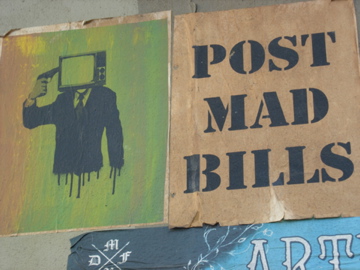 Second and Traction. I wouldn’t have ended up there if three degrees of separation and a vaguely pointing finger hadn’t sent me, the intersection pulsing on my iMap like a gleam off buried treasure. Does every town have a warehouse district—posed delicately between decay and revitalization, a hushed breath that sends the trash dancing ecstatically down deserted streets. Abandoned buildings, chain-link fences, art collectives, lofts, hip cafes on whose terraces a gothic bartender I once knew squinted her eyes against the LA sun (she never did get sober). Dogs and day laborers and cute girls on bicycles—and a shitton on graffiti.
Second and Traction. I wouldn’t have ended up there if three degrees of separation and a vaguely pointing finger hadn’t sent me, the intersection pulsing on my iMap like a gleam off buried treasure. Does every town have a warehouse district—posed delicately between decay and revitalization, a hushed breath that sends the trash dancing ecstatically down deserted streets. Abandoned buildings, chain-link fences, art collectives, lofts, hip cafes on whose terraces a gothic bartender I once knew squinted her eyes against the LA sun (she never did get sober). Dogs and day laborers and cute girls on bicycles—and a shitton on graffiti.
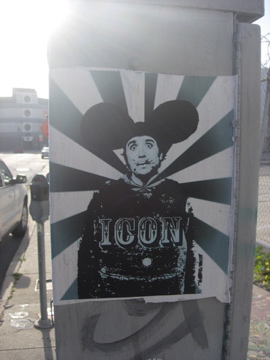

 Down on 9th and Mateo, another abandoned building was getting seriously hit up by some bad-ass murals, part of the LA Freewalls Project. Local boy Saber had just completed an impressive piece, as had D*Face.
Down on 9th and Mateo, another abandoned building was getting seriously hit up by some bad-ass murals, part of the LA Freewalls Project. Local boy Saber had just completed an impressive piece, as had D*Face. And, why not, a couple more gems from elsewhere in the city…
And, why not, a couple more gems from elsewhere in the city…





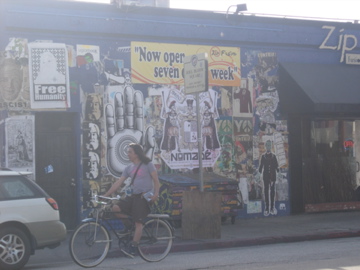

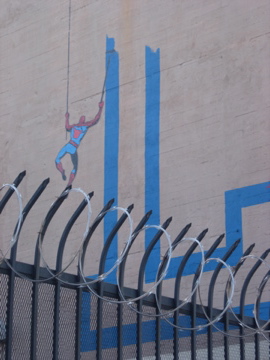

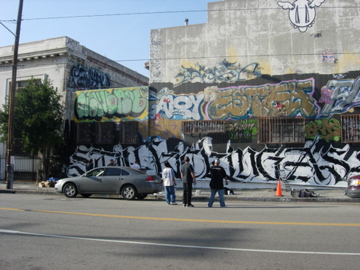












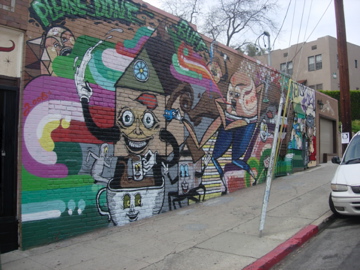
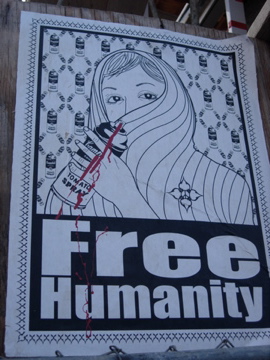




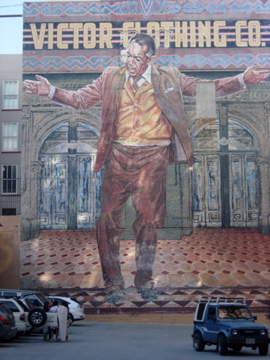
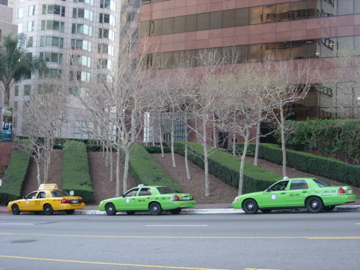






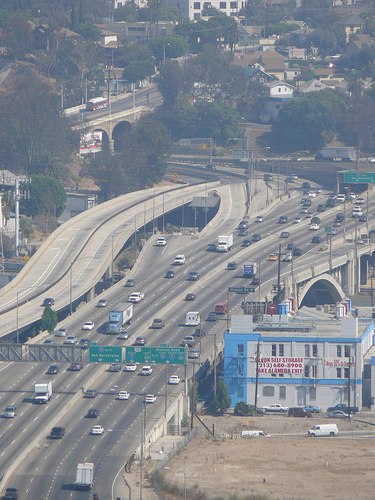
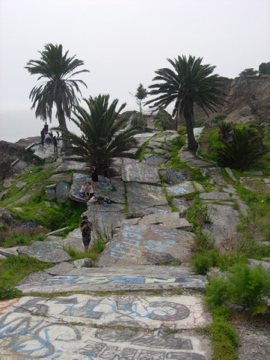



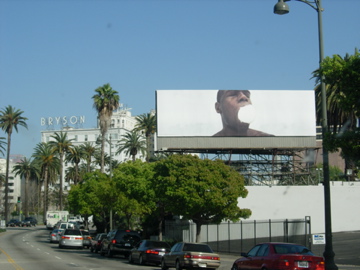






Recent Comments